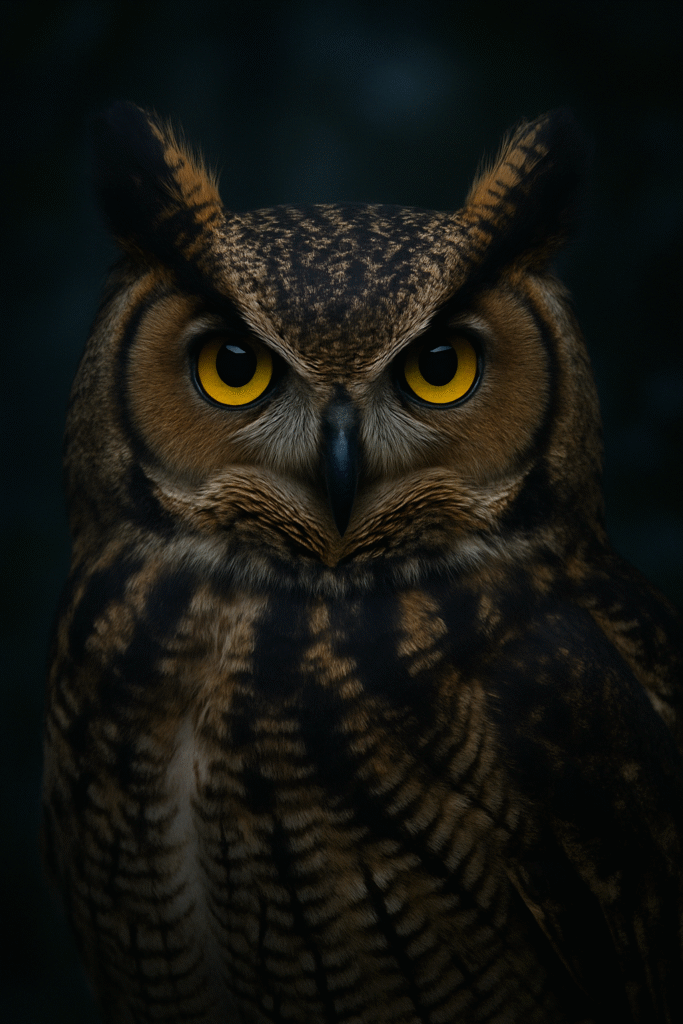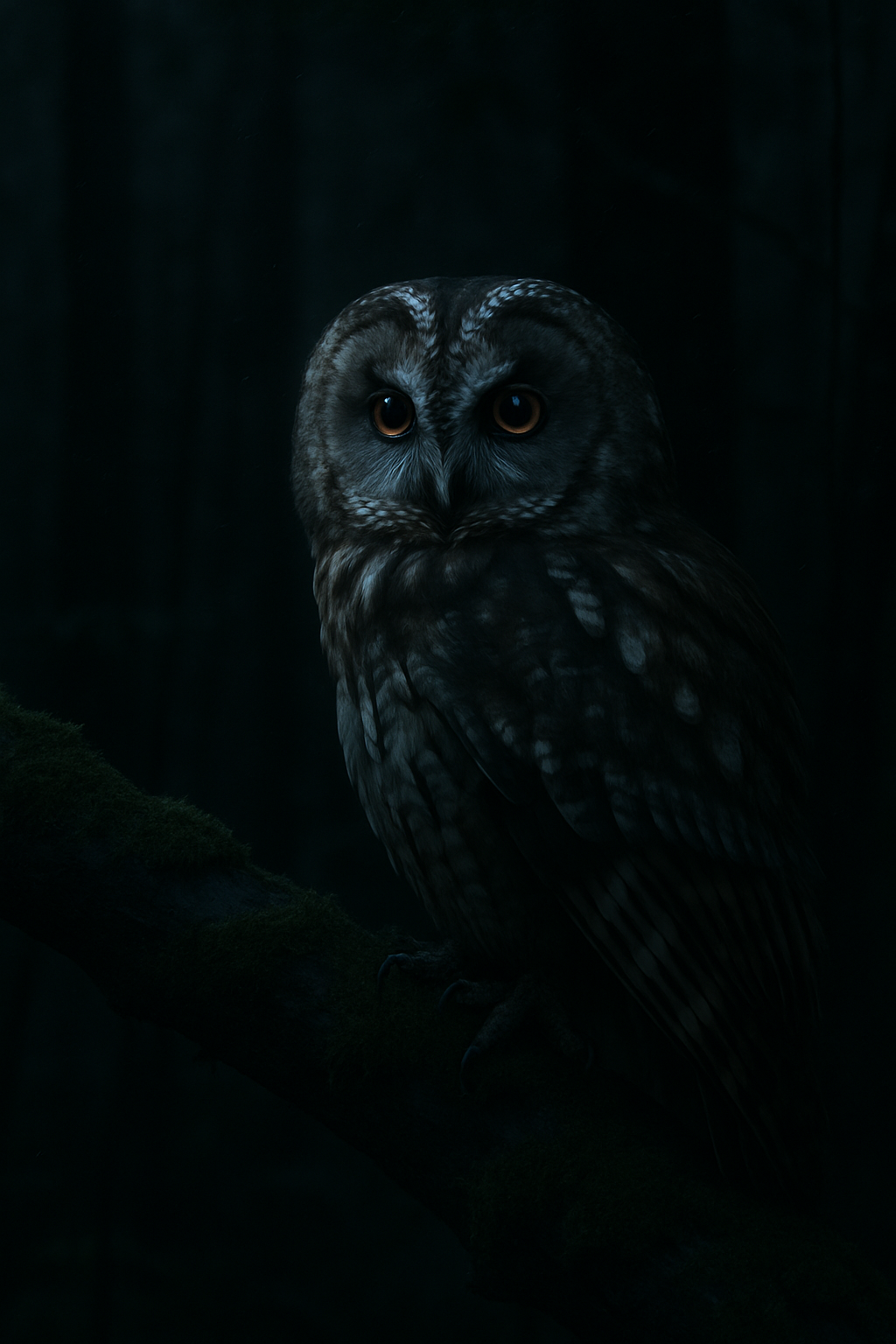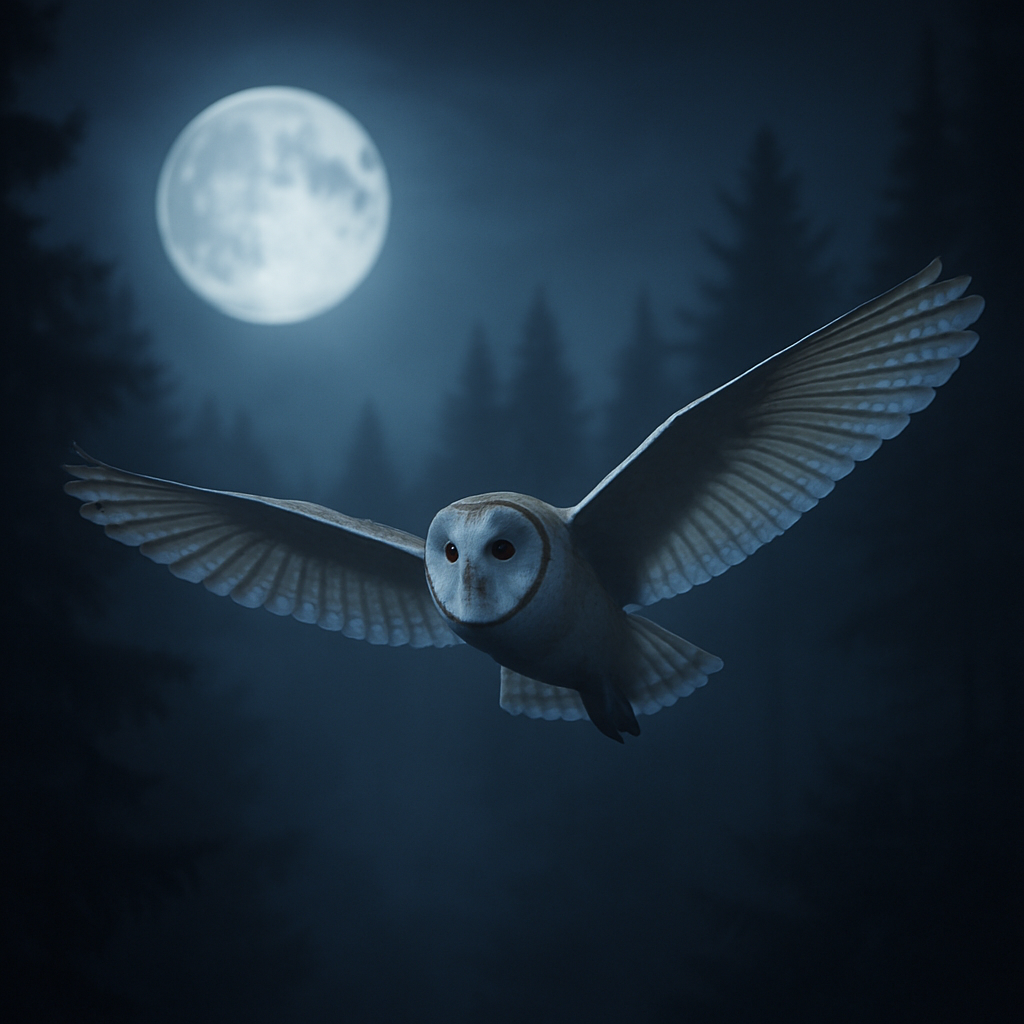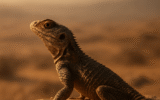A Gaze in the Darkness
The night forest holds a different kind of time. In daylight, life hums with activity; in darkness, the world slows, breathes, and waits. Amid this pause, a shape moves silently through the trees. It is an owl — gliding with spectral grace, wings spread like shadows stitched into the night. Its round eyes, luminous and unblinking, meet ours for an instant, and in that instant something shifts: awe, unease, reverence.
To encounter an owl is not just to see a bird. It is to brush against a symbol woven into millennia of human thought, a creature at once real and otherworldly. Owls have lived alongside us since prehistory — painted in Paleolithic caves, carved into ancient coins, feared in medieval villages, and cherished in Native lore. Across cultures, they are messengers, omens, tricksters, guides, embodiments of wisdom and death alike.

What gives the owl such resonance? The answer lies in a convergence of biology and imagination: the owl’s extraordinary adaptations to the night sky, and humanity’s tendency to mythologize what hides in darkness.
The Science of the Owl
Owls belong to the order Strigiformes, with over 200 species spread across every continent except Antarctica. Their evolutionary success stems from their mastery of nocturnal predation. Each feature of their body is a refinement in the art of silent, precise hunting.
- Silent Flight: Owl feathers are unlike those of any other bird. The leading edge of their wings has serrated fringes that break up air turbulence, while their velvety surfaces dampen sound. As a result, an owl’s flight is almost completely noiseless — an evolutionary advantage that lets them strike without warning.
- Vision: Owl eyes are tube-shaped, not spherical, giving them telescopic power. They cannot roll their eyes, so instead their necks evolved extraordinary mobility: owls can rotate their heads up to 270 degrees without cutting off blood supply, thanks to unique bone and vessel adaptations.
- Hearing: Some species, like the Barn Owl, have asymmetrically placed ears, one higher than the other. This creates a 3D auditory map of the world, letting them triangulate prey in total darkness.
- Predation: Their talons are crushing tools, curved and razor-sharp, capable of dispatching rodents instantly. Combined with their stealth, owls are rodent regulators par excellence, critical to ecosystems and even agriculture.
This perfect predator design is part of why humans long associated owls with uncanny power. In nature, the owl is a silent executioner. In culture, it becomes a vessel of mystery.
Owls Across the World
The diversity of owls reflects the diversity of human landscapes:
- Snowy Owl (Bubo scandiacus): Cloaked in white feathers, these Arctic dwellers symbolize endurance and purity, their stark beauty amplified against endless tundra.
- Barn Owl (Tyto alba): With a heart-shaped face and spectral flight, barn owls have long been symbols of mystery and omens in rural folklore.
- Eurasian Eagle Owl (Bubo bubo): One of the world’s largest owls, with a wingspan over six feet, commanding cliffs and forests like a monarch of the night.
- Burrowing Owl (Athene cunicularia): Unlike its kin, this owl lives in open grasslands, standing tall at burrow entrances, blinking at the sun — a contradiction to its nocturnal cousins.
- Great Horned Owl (Bubo virginianus): Known as the “tiger of the skies,” this formidable predator dominates American ecosystems, adaptable and fearsome.
Each species carries its own aura, shaping the way cultures perceive them.
Owls in Myth and Culture
The owl is a universal archetype, but its meaning shifts wildly across cultures:
- Greece: The owl was sacred to Athena, goddess of wisdom. The “Owl of Athena” adorned Athenian coins, circulating as a symbol of intelligence, strategy, and knowledge.
- Rome: Romans feared owls as portents of death. Legend says an owl’s cry foretold the deaths of Julius Caesar, Augustus, and Agrippa.
- Medieval Europe: The owl was cast as a companion of witches, a soul-snatcher, or a herald of doom. Their cries in villages were feared as omens of plague or misfortune.
- Indigenous North America: For many tribes, owls were guides of the spirit world, warning of dangers or carrying messages between realms. For the Hopi, owls symbolized law enforcement and kept children in line with cautionary tales.
- Africa: In some traditions, owls are tricksters or shapeshifters, associated with sorcery. To see one at night was to know magic was near.
- Hindu Mythology: The owl is the vehicle of Lakshmi, goddess of wealth, symbolizing prosperity and vigilance in Indian traditions.
The cultural weight of the owl lies in its paradoxical nature: wise and sinister, sacred and feared.
Owls as Archetypes
Carl Jung would have called the owl an archetype of the shadow and the sage. Owls inhabit the liminal space between night and day, life and death, ignorance and wisdom. Their forward-facing eyes give them an almost human likeness, uncanny and unsettling.

They embody the unknown: what is hidden, what waits beyond the veil. And so they become symbols of:
- Wisdom (Athena’s companion)
- Death (omens in Europe, Rome)
- Prophecy (guides in Indigenous lore)
- Transformation (messengers in African traditions)
Few animals contain such contradictory symbolic power.
Owls in Antiquity and Literature
From prehistory to poetry, the owl has always perched in the margins of human imagination.
- Paleolithic cave art in France depicts owls, showing reverence even in pre-agricultural societies.
- Mesopotamian art linked owls to Lilith, spirits of the night.
- Medieval bestiaries portrayed owls as sinners shunning the light of God.
- Shakespeare used owls as omens: in Macbeth, the “fatal bellman” foretells Duncan’s murder.
- Romantic poets saw owls as guardians of solitude, watching over the lonely wanderer.
- Modern fantasy elevated owls as familiars, from Harry Potter’s Hedwig to countless fictional messengers between worlds.
The owl is always there — in margins, in shadows, in metaphors — a symbol too potent to ignore.
Modern Science and Conservation
Beyond myth, owls are subjects of serious science. Their flight mechanics inspire aerospace engineering: NASA and aviation researchers study owl feathers for quieter drones and aircraft. Their role as bioindicators helps ecologists measure environmental health, since owls decline when ecosystems destabilize.
But they are also at risk. Deforestation, habitat loss, pesticide poisoning, and climate change are eroding populations. The Spotted Owl in North America became a conservation symbol, embodying the conflict between timber industries and ecological preservation.
Conserving owls is more than saving a bird. It is preserving cultural heritage, ecological balance, and evolutionary marvels.
Philosophical Reflection
The owl teaches us humility. We call it wise, but its wisdom is not human — it is the wisdom of adaptation, silence, patience. The owl does not explain; it watches. In its gaze, we sense truths we cannot articulate: the inevitability of death, the persistence of mystery, the beauty of what lies beyond sight.

The philosopher Hegel wrote:
“The owl of Minerva spreads its wings only with the falling of dusk.”
Wisdom comes too late, when darkness has already arrived. The owl is our reminder that understanding often follows, rather than precedes, experience.
Closing Scene
The night deepens. A moon hangs above the forest canopy. In the stillness, a shadow passes soundlessly, landing on a branch. The owl turns, eyes gleaming with an ancient calm, its presence more felt than seen. Then, without warning, it lifts into the air, swallowed by the night.
What remains is silence — and the sense that we have been touched by something beyond ourselves.
The owl persists as hunter, omen, sage, and shadow — a creature of science and myth, of biology and philosophy, reminding us that the world is richer when mystery endures.


Reply